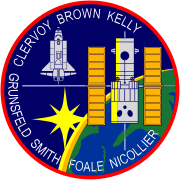This article needs additional citations for verification. (April 2024) |
 Grunsfeld and Smith replacing gyroscopes on Hubble during the mission's first EVA | |
| Names | Space Transportation System-103 |
|---|---|
| Mission type | Hubble Space Telescope servicing |
| Operator | NASA |
| COSPAR ID | 1999-069A |
| SATCAT no. | 25996 |
| Mission duration | 7 days, 23 hours, 11 minutes 34 seconds |
| Distance travelled | 5,230,000 kilometres (3,250,000 mi) |
| Spacecraft properties | |
| Spacecraft | Space Shuttle Discovery |
| Launch mass | 112,493 kilograms (248,005 lb) |
| Landing mass | 95,768 kilograms (211,132 lb) |
| Crew | |
| Crew size | 7 |
| Members | |
| EVAs | 3 |
| EVA duration | 24 hours, 33 minutes |
| Start of mission | |
| Launch date | 20 December 1999 00:50:00 UTC |
| Launch site | Kennedy, LC-39B |
| End of mission | |
| Landing date | 28 December 1999 00:01:34 UTC |
| Landing site | Kennedy, SLF Runway 33 |
| Orbital parameters | |
| Reference system | Geocentric |
| Regime | Low Earth |
| Perigee altitude | 563 kilometres (350 mi) |
| Apogee altitude | 609 kilometres (378 mi) |
| Inclination | 28.45 degrees |
| Period | 96.4 minutes |
| Capture of Hubble | |
| RMS capture | 22 December 1999, 00:34 UTC[1] |
| RMS release | 25 December 1999, 11:03 UTC[2] |

 Left to right; C. Michael Foale, Claude Nicollier, Scott J. Kelly, Curtis L. Brown Jr., Jean-Francois Clervoy, John M. Grunsfeld and Steven L. Smith | |
STS-103, the 96th launch of the Space Shuttle and the 27th launch of Space Shuttle Discovery, was a Hubble Space Telescope servicing mission. It launched from Kennedy Space Center, Florida, on 19 December 1999 and returned on 27 December 1999 and was the last Shuttle mission of the 1990s. It was the only mission to span through Christmas after being delayed by 13 days for technical and weather reasons.
- ^ NASA (21 December 1999). "STS-103, Mission Control Center Status Report #05". Johnson Space Center Mission Status Reports. Houston, TX. Archived from the original on 28 January 2021. Retrieved 28 January 2021.
- ^ NASA (26 December 1999). "STS-103, Mission Control Center Status Report #14". Johnson Space Center Mission Status Reports. Houston, TX. Archived from the original on 28 January 2021. Retrieved 28 January 2021.